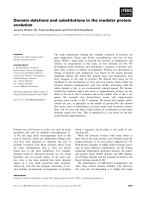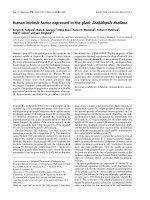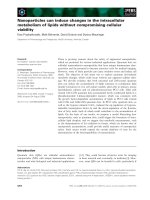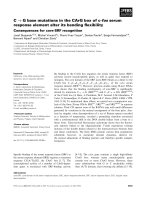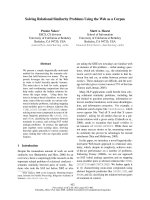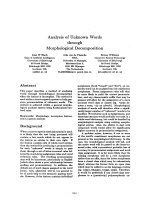Báo cáo khoa học: "Histochemistry of Six Lectins in the Tissues of the Flat Fish Paralichthys olivaceus" potx
Bạn đang xem bản rút gọn của tài liệu. Xem và tải ngay bản đầy đủ của tài liệu tại đây (603.91 KB, 9 trang )
J O U R N A L O F
Veterinary
Science
J. Vet. Sci. (2002), 3(4), 293-301
Abstract
7)
Lectins are glycoproteins that specifically bind
carbohydrate structures and may participate in the
biodefense mechanisms of fish. In this study, the
binding of three lectins,
Dolichos biflorus
agglutinin
(DBA), soybean agglutinin (SBA),
Bandeiraea sim-
plicifolia
BS-1 (isolectin B4),
Triticum vulgaris
(WGA),
Arachis hypogaea
(PNA) and
Ulex europaeus
(UEA-I)
w ere studied in the gill, liver, intestine, kidney, heart,
and spleen of the flat fish
Paralichthys olivaceus
.
DBA w as detected in intestinal mucous cells, as well
as in gill epithelial and mucous cells. It w as w eakly
detected in renal tubule epithelial cells and in bile
duct epithelial cells. The strong SBA staining w as
seen in the intestinal club cells, in bile duct epithelial
cells and renal tubule epithelial cells. There were
intense positive reactions for isolectin B4 in gill
epithelial and mucous cells, and the strong isolectin
B4 staining was seen in epithelial cells of the bile
duct and intestine. The strong WGA staining was seen
in the gill mucosal cells, sinusoid, renal tubule
epithelial cells and mucosal cells of the intestine.
UEA-I w as detected in the gill epithelial and mucosal
cells, bile duct epithelial cells and renal tubular
epithelial cells.
These re sults suggest that the six lectins examined
w ere localized in the cove ring epithelia of the various
organs of the flat fish and they may participate in the
biodefense mechanism of the intra body surface in
w hich is exposed to various antigens.
Key w ords :
lectin, flat fish, DBA, SBA, isolectin B4, WGA,
PNA, UEA-I.
*
Corresponding author: Tae-Kyun Shin
Department of Veterinary Medicine, Graduate School,
Cheju National University, Jeju 690-756, Republic of Korea
Tel : +82-64-754-3363, Fax : +82-64-756-3354
E-mail:
Introduction
Lectins are carbohydrate-binding proteins of nonimmune
origin that are widely distributed in nature [11]. Lectin
binding to the carbohydrate moieties of glycoproteins and
glycolipids is important for a variety of biological processes,
including cellular adhesion [14], cellular recognition [12],
protein folding [7] and signal transduction [3, 10]. All lectin
molecules possess two or more carbohydrate-binding sites, a
property that is essential for their ability to agglutinate
cells or react with complex carbohydrates [22]. Each lectin
binds to a specific sugar or group of sugars [20]. Many lectins
have been characterized, including peanut agglutinin, wheat
germ agglutinin, phytochemagglutinin E, concanavalin A,
Dolichos biflorus agglutinin (DBA), soybean agglutinin (SBA)
and Bandeiraea simplicifolia BS-1 (isolectin B4) [6, 21].
In a previous study, it was shown that SBA is a member
of the legume family of plant lectins, which have important
biological properties, including the induction of mitogenicity
in lymphocytes [18]. DBA has carbohydrate specificity for
a-linked N-acetylgalactosamine, and DBA-binding targets
are expressed specifically in the epithelium of various embryonic
mouse organs [4, 17]. The plant lectin Bandeiraea simplicifolia
(isolectin B4) has a high affinity for a-D-galactose residues
in the carbohydrate chains of membrane-associated glyco-
conjugates [5, 8]. Isolectin B4 was also found in numerous
phagocytic macrophages and reactive microglia in and around
tumors, which had a similar distribution to that of quinolinate
immunoreactive cells [13] and vasoformative endothelial
cells from the rat aorta [16]. Mucus is an indispensable
chemical barrier in the fish immune system. It contains
diverse molecules that may participate in innate or acquired
immunity. Among others, lectin and lectin-like molecules
are found in the cutaneous mucus of many fish species [1].
It is generally accepted that fish cutaneous lectin
contributes to the biodefense system on the body surface
because of its agglutinating activity [15].
The flat fish Paralichthys olivaceus is important for the
Jeju fish culture industry. To improve culture conditions, it
is useful to understand biodefense systems in culture fish.
Little is known about the distribution pattern of lectins,
which are known to be one of various molecules involved in
Histochemistry of Six Lectins in the Tissues of the Flat Fish Paralichthys olivaceus
Kyung-Sook Jung1, Mee-Jung Ahn1, Yong-Duk Lee1, Gyung-Min Go2 and Tae-Kyun Shin1*
1Department of Veterinary Medicine, Graduate School, Cheju National University, Jeju 690-756, Republic of Korea
2Jeju Province Fisheries Resources Research Institute, Jeju 699-810, Republic of Korea
Received July 20, 2002 / Accepted November 20, 2002
294 Kyung-Sook Jung, Mee-Jung Ahn, Yong-Duk Lee, Gyung-Min Go and Tae-Kyun Shin
fish biodefense.
The aim of this study was to localize six lectins including
DBA, SBA, isolectin B4, WGA, PNA and UEA-I, in the
various tissues of the flat fish Paralichthys olivaceus, and to
postulate their functional role in the biodefense mechanism
of this fish.
Materials and methods
2.1. Fish
Flat fish, Paralichthys olivaceus, weighing 100 to 200 g
were kept in a flow-through seawater system at ambient
temperature (mean 20 ± 2 ) for 5 months in the Jeju
Province Fisheries Resources Research Institute. Fish were
fed twice daily, and weighed 300 to 400 g at the time of
sacrifice (n=5).
2.2. Sampling proce dure
Following sacrifice, the liver, kidney, gill, gastrointestinal
tract, heart and spleen of each fish were fixed in 10%
buffered formalin for 48 hr to prepare for histological
examination.
2.3. Histological examination
Specimens were fixed in 10% buffered formalin,
embedded in paraffin, sectioned at 5
㎛
, and stained with
hematoxylin and eosin using routine histological techniques.
All paraffin-embedded tissue sections from normal fish were
stained for the lectin study.
2.4. Le ctins
The lectins used in this study were Bandeiraea
simplicifolia agglutinin (peroxidase-labeled isolectin B4,
Sigma, St. Louis, MO), Dolichos biflorus agglutinin
(peroxidase-labeled DBA, Sigma), glycine max agglutinin
(peroxidase-labeled SBA, Sigma), Triticum vulgaris
agglutinin (peroxidase-labeled WGA, Sigma), Arachis
hypogaea agglutinin (peroxidase-labeled PNA, Sigma) and
Ulex europaeus agglutinin I (peroxidase-labled UEA-I,
Sigma). The specificity of lectins is summarized in Table 1.
2.5. Histochemistry
Tissues were dehydrated by immersion in a graded
ethanol series (70, 80, 90, 95 and 100%), cleared in xylene,
embedded in paraffin wax and sectioned at 5
㎛
on a
microtome. The sections were mounted on glass microscope
slides, the wax was removed, and sections were hydrated.
Endogenous peroxidase activity was blocked with 0.3%
hydrogen peroxide in methanol for 30 min. After three
washes with PBS, the sections were exposed to 10% normal
horse serum, and then incubated with DBA-peroxidase
(diluted 1:10), SBA-peroxidase (diluted 1:400), isolectin
B4-peroxidase (diluted 1:50), WGA-peroxidase (diluted 1:
20), PNA-peroxidase (diluted 1: 10) or UEA-I-peroxidase
(diluted 1: 10) for 3 hrs at room temperature. Peroxidase
was developed with diaminobenzidine (DAB)-hydrogen
peroxidase solution (0.001% 3,3
′
diaminbenzidine and 0.01%
hydrogen peroxidase in 0.05M Tris buffer). The sections
were counterstained with hematoxylin before being
mounted.
Results
Histological examination showed that all tissues,
including gill, liver, gastrointestinal track, kidney, heart
and spleen, were devoid of inflammatory cells, and all
tissues were used for lectin histochemistry.
In the gill, DBA (Fig. 1A), SBA (Fig. 1B) and isolectin B4
(Fig. 1C) were specifically detected in the epithelial cells of
the gill filament. The covering cells of the gill were largely
positive for isolectin B4 (Fig. 1C). WGA (Fig. 1 D) and
UEA-I (Fig. 1 F) were detected in mucus and epithelial cells,
while PNA (Fig. 1 E) was localized in few epithelial cells of
the gill filament.
DBA, SBA and isolectin B4 were weekly detected the gill
racker (Fig. 2A, B and C). In the mucosal epithelium, WGA
and UEA-I were strongly detected in the mucosal cells
(arrow head) and gill racker (arrow) (Fig. 2D and F). But
PNA was not detected in all cells (Fig. 2E).
In the skin, a few mucous cells were positive for isolectin
B4, but no other lectins were detected.
Table 1.
Lectin specificity
Lectin Abbreviation Binding spe cificity
N-acetylgalactosamine group
Bandeiraea simplicifolia lectin
Dolichos biflorus agglutinin
Glycine max (soybean agglutinin)
isolectin B4
DBA
SBA
α
GalNAc,
α
Gal
α
GalNAc
α
GalNAc
N-acetylglucosamine group
Triticum vulgaris (wheat germ) WGA
β
GlcNAc
Galactose group
Arachis hypogaea (peanut) PNA
β
Gal
Fucose group
Ulex europaeus-
Ⅰ
UEA-
Ⅰ α
Fuc
Histochemistry of Six Lectins in the Tissues of the Flat Fish Paralichthys olivaceus 295
In the liver, some bile duct epithelial cells were intensely
positive for SBA (Fig. 3B), while only a few were positive for
isolectin B4 (Fig. 3C). DBA (Fig. 3A) and PNA (Fig. 3E),
however, was not detected in any liver cells. WGA was
detected in the sinusoid (Fig. 3D), and UEA-I(Fig. 3F)
expression was similar to detection of SBA. There was no
lectin reaction in the hepatocytes.
In the esophagus, only isolectin B4 was detected in a few
mucous cells and epithelial cells. No lectins were detected in
the stomach.
In the intestine, DBA was detected in the intestinal gland
mucous cells (Fig. 4A). SBA was expressed in the club cells
(Fig. 4B), while isolectin B4 was detected in the epithelial
cells (Fig. 4C). The club cells had round heads with a large
secretory vacuole situated either above or below the nucleus.
WGA was detected in the club cells (Fig. 4D), while UEA-I
was detected in the brush border (Fig. 4F). But, PNA was
not expressed in the intestine cells (Fig. 4E).
In the kidney (Fig. 5), five lectins were detected in renal
tubule epithelial cells, although DBA (Fig. 5A) was less
abundant than the other four lectins and PNA (Fig. 5E) was
not detected. No lectin reaction was detected in the heart or
spleen (data not shown). The histochemical reaction of the
six lectins in the gill, liver, skin, gastrointestinal tract and
kidney are summarized in Table 2.
Discussion
This is the first study to examine the binding of the 6
lectins including DBA, SBA, isolectin B4, WGA (D), PNA (E)
and UEA-I (F) in the cultured flat fish. Both SBA and
isolectin B4 showed consistent binding in gastrointestinal
epithelial cells, while DBA was limited to epithelial cells in
the gill. These findings imply that some lectins preferentially
bind to mucosal epithelial cells that may be in contact with
various antigens. These findings are in part consistent with
those of a previous study, which confirmed that gelectin is
strongly expressed in the club cells of the gill, upper
alimentary canal, and skin, and postulated that congerin (
β
-galactoside binding lectin) participates in the biodefense
against pathogenic microorganisms and parasites [15].
The physiological and immunological importance of lectins
in fish slime has not been sufficiently clarified. Gelatins, one
of the major families of animal lectins, exist in a wide range
of animal tissue and seem to participate in diverse biological
processes, such as immune response modulation [19] and
Table 2.
Histochemical localization of Dolichos biflorus agglutinin (DBA), soybean agglutinin (SBA), Bandeiraea simplicifolia
BS-1 (isolectin B4), Triticum vulgaris (WGA), Arachis hypogaea (PNA) and Ulex europaeus (UEA-I)-positive cells
in the tissues of normal Paralichthys olivaceus
Tissue Positive cells
Lectin
DBA SBA
Isolectin
B4
WGA PNA UEA-
Ⅰ
Gill Epithelial cells
Mucous cells
Gill racker
+
+
+
+
+
+
++
++
+
+
++
+
+
-
-
+
++
+
Liver Epithelial cells of the bile duct
Hepatocyte
Sinusoid
-
-
-
++
-
-
+
-
-
+
-
++
-
-
-
+
-
-
Esophagus
Epithelial cells
Mucous cells
-
-
-
-
+
+
-
-
-
-
-
-
Stomach Epithelial cells
Mucous cells
-
-
-
-
-
-
-
-
-
-
-
-
Skin Mucous cells
- - + - - -
Intestine Epithelial cells
Mucous cells
Club cells
Brush border
+
++
-
-
+
-
++
-
++
-
-
-
+
++
-
-
-
-
-
-
-
-
-
++
Kidney
Epithelial cells of renal tubule
Glomerulus
+
-
++
-
++
-
++
--
-
-
++
-
Heart Cardiac muscle
- - - - - -
Spleen Lymphoid cells
- - - - - -
-
No binding,
+
weak binding,
++
intense binding. (Andreas G. et al., 2000)
296 Kyung-Sook Jung, Mee-Jung Ahn, Yong-Duk Lee, Gyung-Min Go and Tae-Kyun Shin
Fig. 1.
Histochemical staining of DBA (A), SBA (B), isolectin B4 (C), WGA(D), PNA(E) and UEA-I(F) in the gill filament
of the flat fish, Paralichthys olivaceus. Lectins including DBA (A), SBA (B), isolectin B4 (C), WGA(D), PNA(E) and UEA(F)
were specifically expressed in the mucus (arrow) and epithelial (arrowhead) cells of the gill. Counterstaining with
hematoxylin. Scale bar = 30
㎛
.
Histochemistry of Six Lectins in the Tissues of the Flat Fish Paralichthys olivaceus 297
Fig. 2.
Histochemical staining of DBA (A), SBA (B), isolectin B4 (C), WGA(D), PNA(E) and UEA-I(F) in the gill arch of the
flat fish, Paralichthys olivaceus. Lectins, DBA (A), SBA (B), isolectin B4 (C), WGA(D) and UEA(F) were specifically expressed
in the mucosal (arrow) and gill racker (arrowhead) cells of the gill. PNA(E) was not expressed. Counterstaining with
hematoxylin. Scale bar = 30
㎛
.
298 Kyung-Sook Jung, Mee-Jung Ahn, Yong-Duk Lee, Gyung-Min Go and Tae-Kyun Shin
Fig. 3.
Histochemical staining of DBA (A), SBA (B), isolectin B4 (C), WGA(D), PNA(E) and UEA-I(F) in the liver. Some
epithelial cells of the bile duct were positive for SBA (B), isolectin B4 (C) and UEA-I(F), but DBA(A) and PNA(E) was not
seen in the liver. WGA(D) was expressed in the sinusoid. Counterstaining with hematoxylin. Scale bar = 30
㎛
.
Histochemistry of Six Lectins in the Tissues of the Flat Fish Paralichthys olivaceus 299
Fig. 4.
Histochemical staining of DBA (A), SBA (B), isolectin B4 (C), WGA(D), PNA(E) and UEA-I(F) in the intestine. DBA
(A), isolectin B4 (C) and WGA(D) were expressed in mucous cells (A), while SBA was expressed in club cells (B) and UEA-I(F)
was expressed in brush border. PNA(E) was not expressed. Counterstaining with hematoxylin. Scale bar = 30
㎛
.
300 Kyung-Sook Jung, Mee-Jung Ahn, Yong-Duk Lee, Gyung-Min Go and Tae-Kyun Shin
Fig. 5.
Histochemical staining of DBA (A), SBA (B), isolectin B4 (C), WGA(D), PNA(E) and UEA-I(F) in the kidney. SBA
(B), isolectin B4 (C), WGA(D) and UEA-I(F) were detected in renal tubule epithelial cells. PNA(E) was not expressed.
Counterstaining with hematoxylin. Scale bar = 30
㎛
Histochemistry of Six Lectins in the Tissues of the Flat Fish Paralichthys olivaceus 301
cell growth regulation [23]. Protection from pathogens may
be a potential role for fish mucosal lectin and epithelial
lectin, although that role was not examined in this study.
It is generally assumed that fish mucous lectins are
involved in innate immunity against microorganisms. Studies
have suggested that in some fishes, the mucosal agglutinins
are sufficient for excluding bacteria from the skin [9].
The six lectins examined in the present study are also
expressed in cell groups that are involved in mucus secretion
in the epithelia of various organs. Based on the distribution
of these lectins, DBA, SBA, isolectin B4, WGA, PNA and
UEA-I may also have a biodefensive role in flat fish.
These results show that lectins are preferentially restricted
to the epithelial cells of the covering mucosa in cultured flat
fish, and suggest that they are involved in the biodefense
mechanism of fish. Further study is needed to confirm their
exact role during pathophysiological conditions such as
bacterial infection.
Acknowledgements
This work was supported by a grant from the Ocean
Technology Center, Ministry of Ocean and Fishery, Seoul,
Republic of Korea.
References
1.
Alexander, J. B., Ingram, G. A.
Noncellular nonspecific
defense mechanisms of fish. Ann. Rev. Fish Dis. 1992,
2
, 249-279.
2.
Andreas, G., Kais, A.S., Kerstin, W., Susanne, F.,
Anke, G.
The apical membrane of intestinal brush cells
possesses a specialized, but species-specific, composition
of glycoconjugates on-section and in vivo lectin labeling
in rats, guinea pigs and mice. Histochem. Cell Biol.
2000,
113
, 389-399.
3.
Brandley, B. K., Schnaar, R. L.
Cell-surface carbo-
hydrates in cell recognition and response. J. Leukocyte
Biol. 1986,
40
, 97-111.
4.
Carter, W.G., Etzler, M.E.
Isolation characterization
and subunit structures of multiple forms of Dolichos
biflorus lectin. J. Biol. Chem. 1975,
250
, 2756-2762.
5.
DeBray, H., DeCout, D., Strecker, G., Spik, G.,
Montreuil, J.
Specificity of twelve lectins towards
oligosaccharides and glycopeptides related to N-glycosyl-
proteins. Eur. J. Biochem. 1981,
117
, 41-55.
6.
Engel, U., Breborowicz, D., Bog-Hansen, T., Francis,
D.
Lectin staining of renal tubules in normal kidney.
APMIS. 1997,
105
, 31-34.
7.
Helenius, A.
How N-linked oligosaccharides affect
glycoprotein folding in the endoplasmic reticulum. Mol.
Cell. Biol. 1994,
5
, 253-265.
8.
Hayes, C.E., Goldstein, I.J.
An a-D-galactosyl-binding
lectin from Bandeiraea simplicifolia seeds. J. Biol. Chem.
1974, 249, 1904-1914.
9.
Kosuga, Y., Mno, N., Hirose, H.
Bacterial agglutinins
in the skin mucus of Japanese eel. Fish Pathol. 2000,
35
, 73-77.
10.
Lasky, L.
Selectins: interpreters of cell-specific carbo-
hydrate information during inflammation. Science 1992,
258
, 964-969.
11.
Lis, H., Sharon, N.
Protein glycosylation. Structural
and functional aspects. Eur. J. Biochem. 1993,
218
, 1-27.
12.
McEver, R. P., Moore , K. L., Cumming, R. D.
Leukocyte trafficking mediated by selectin-carbohydrate
interactions. J . Biol. Chem. 1995,
270
, 11025-11028.
13.
Moffett, J.R., Els, T., Espey, M.G., Walter, S.A., Streit,
W.J., Namboodiri, M.A.
Quinolinate immunoreactivity
in experimental rat brain tumors is present in
macrophages but not in astrocytes. Exp. Neurol. 1997,
144(2)
, 287-301.
14.
Moore, K. L., Varki, A., McEver, R. P.
GMP-140
binds to a glycoprotein receptor on human neutrophils:
evidence for a lectin-like interaction. J. Cell Biol. 1991,
112
, 491-499.
15.
Nakamura, O., Watanabe, T., Kamiya, H., Muramoto,
K.
Galectin containing cells in the skin and mucosal
tissues in J apanese conger eel, Conger Myriaster: an
immunohistochemical study. Dev. Comp. Immunol. 2001,
25
, 431-437.
16.
Nicosia, R.F., Villaschi, S., Smith, M.
Isolation and
characterization of vasoformative endothelial cells from
the rat aorta. In Vitro Cell Dev. Biol. Anim. 1994,
30A(6)
,
394-399.
17.
Noguchi, M., Noguchi, T., Watanabe, M., Muramatsu,
T.
Localization of receptors for Dolichos biflorus
agglutinin in early post implantation embryos in mice,
J. Embryol. Exp. Morphol. 1982,
72
, 39-52.
18.
Novogrodsky, A., Katchalski, E.
Induction of lymphocyte
transformation by sequential treatment with neuraminidase
and galactose oxidase E. Proc. Natl. Acad. Sci. USA.
1973,
70
, 1824-1827.
19.
Offner, H., Celnik, B., Bringman, T.S., Casentini-
Borocz, D., Nedwin, G.E., Vandenbark, A.A.
Recom-
binant human beta-galactoside binding lectin suppresses
clinical and histological signs of experimental autoimmune
encephalomyelitis. J. Neuroimmunol. 1990,
28(2)
, 177-184.
20.
Sharon, N., Lis, H.
Carbohydrates in cell recognition.
Scientific Am. 1993, 268, 74-81.
21.
Sozmen, M., Brown, P., Eveson, J.
Lectin histochemistry
of dog major and minor salivary glands. J. Comp.
Pathol. 1999,
121
, 311-319.
22.
Wu, A.M., Sugii, S., Herp, A.
A guide for carbohydrate
specificities of lectins. Adv. Exp. Med. Biol. 1988, 228,
819-847.
23.
Yamaoka, K., Ohno, S., Kawasaki, H., Suzuki, K.
Overexpression of a beta-galactoside binding protein
causes transformation of BALB3T3 fibroblast cells.
Biochem. Biophys. Res. Com. 1991,
179(1)
, 272-279.
